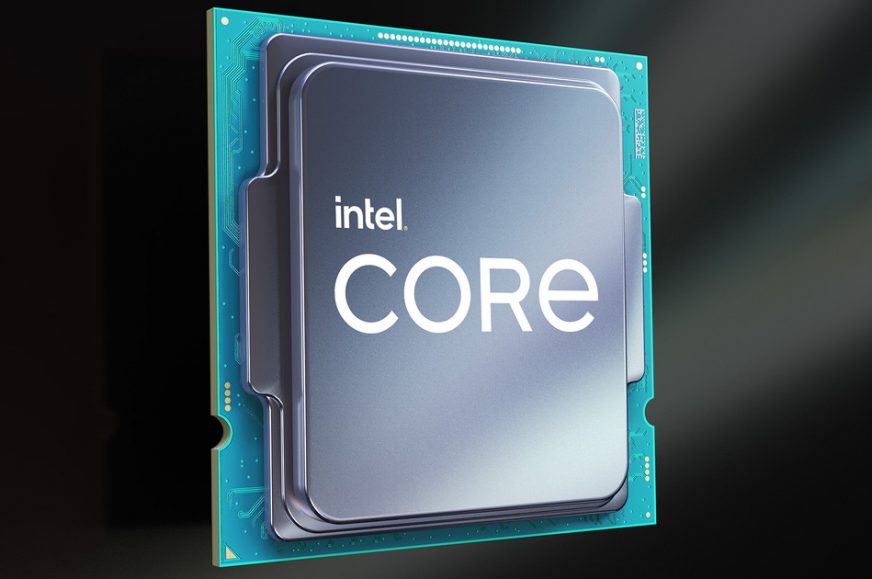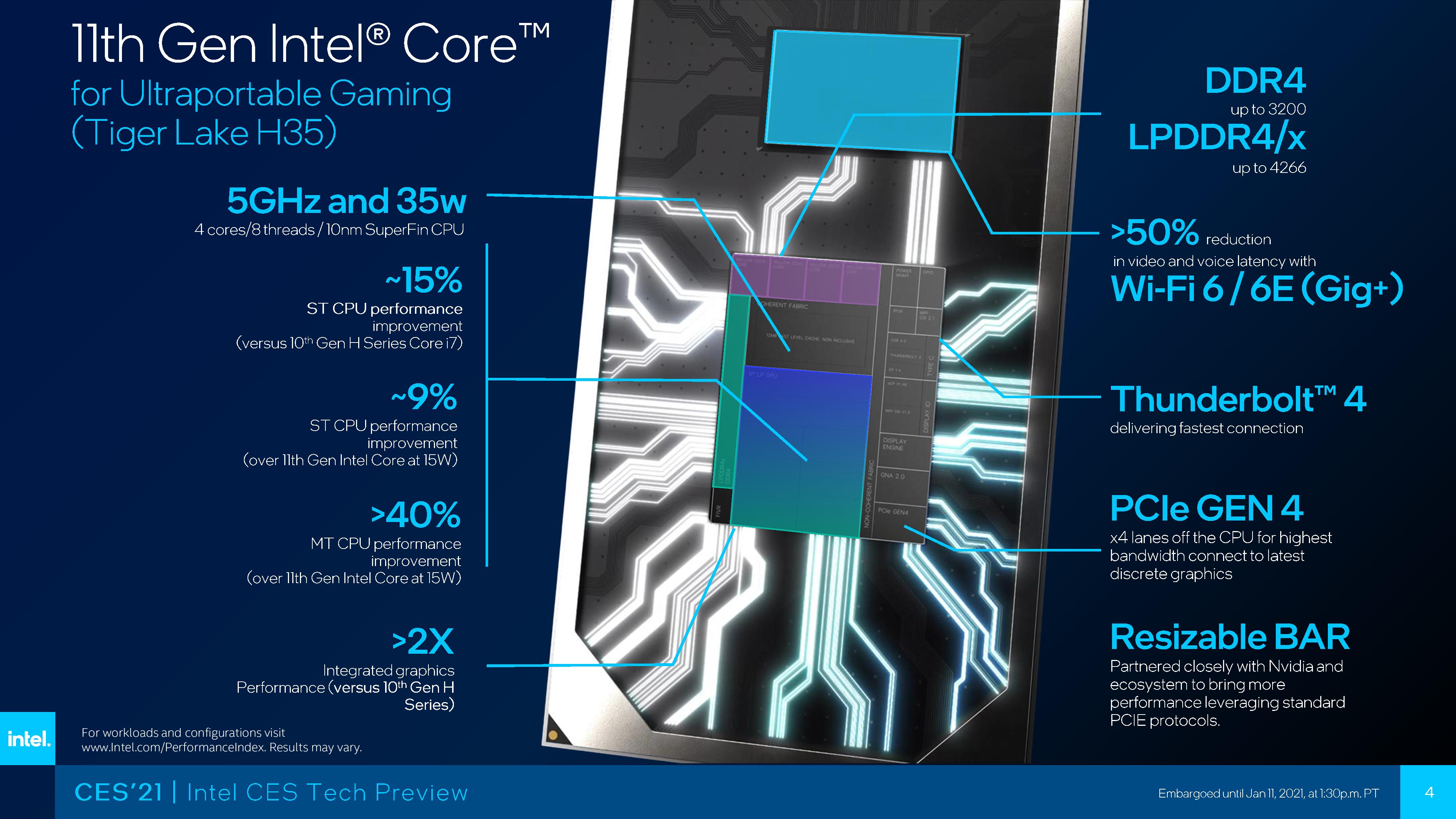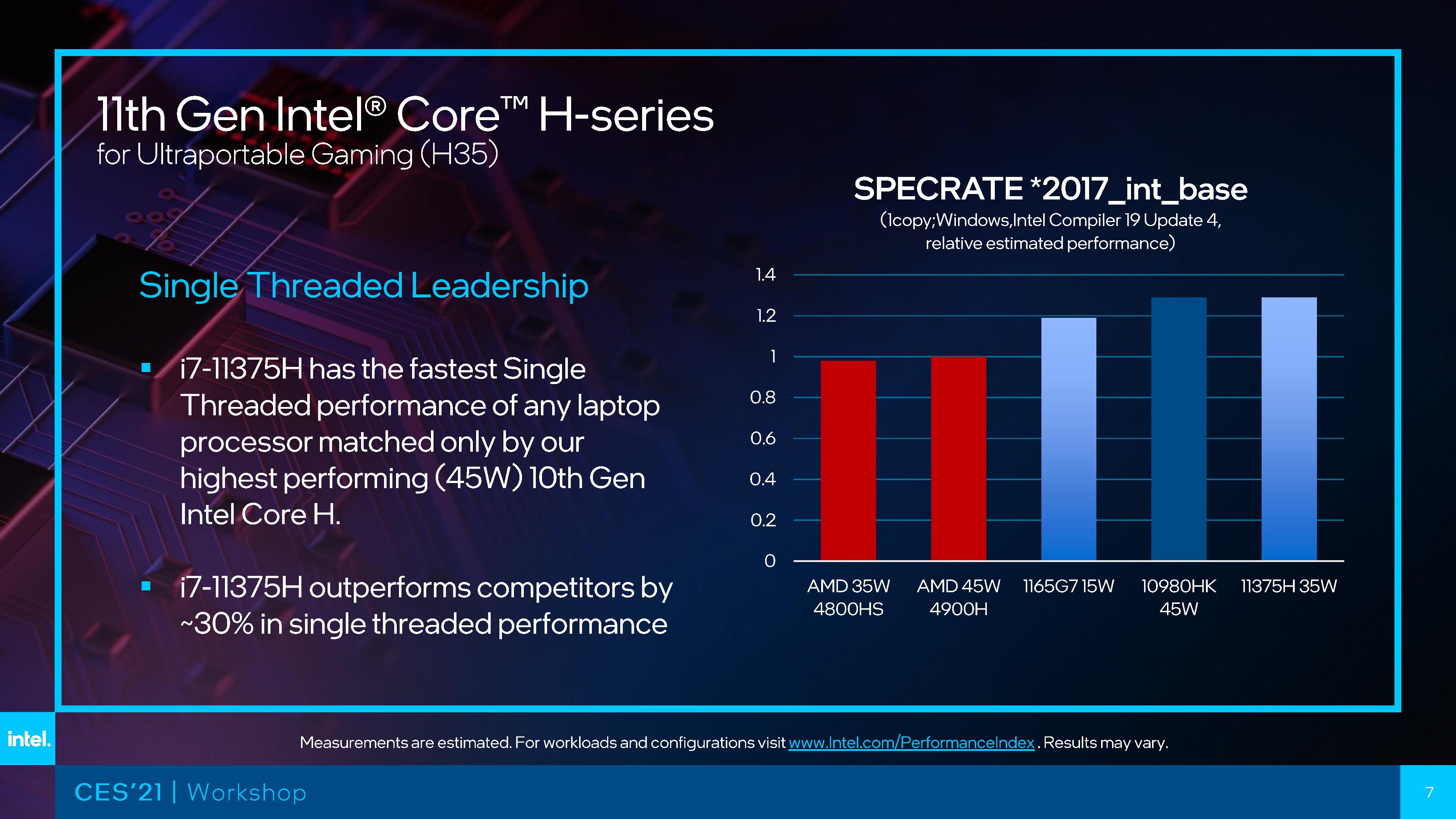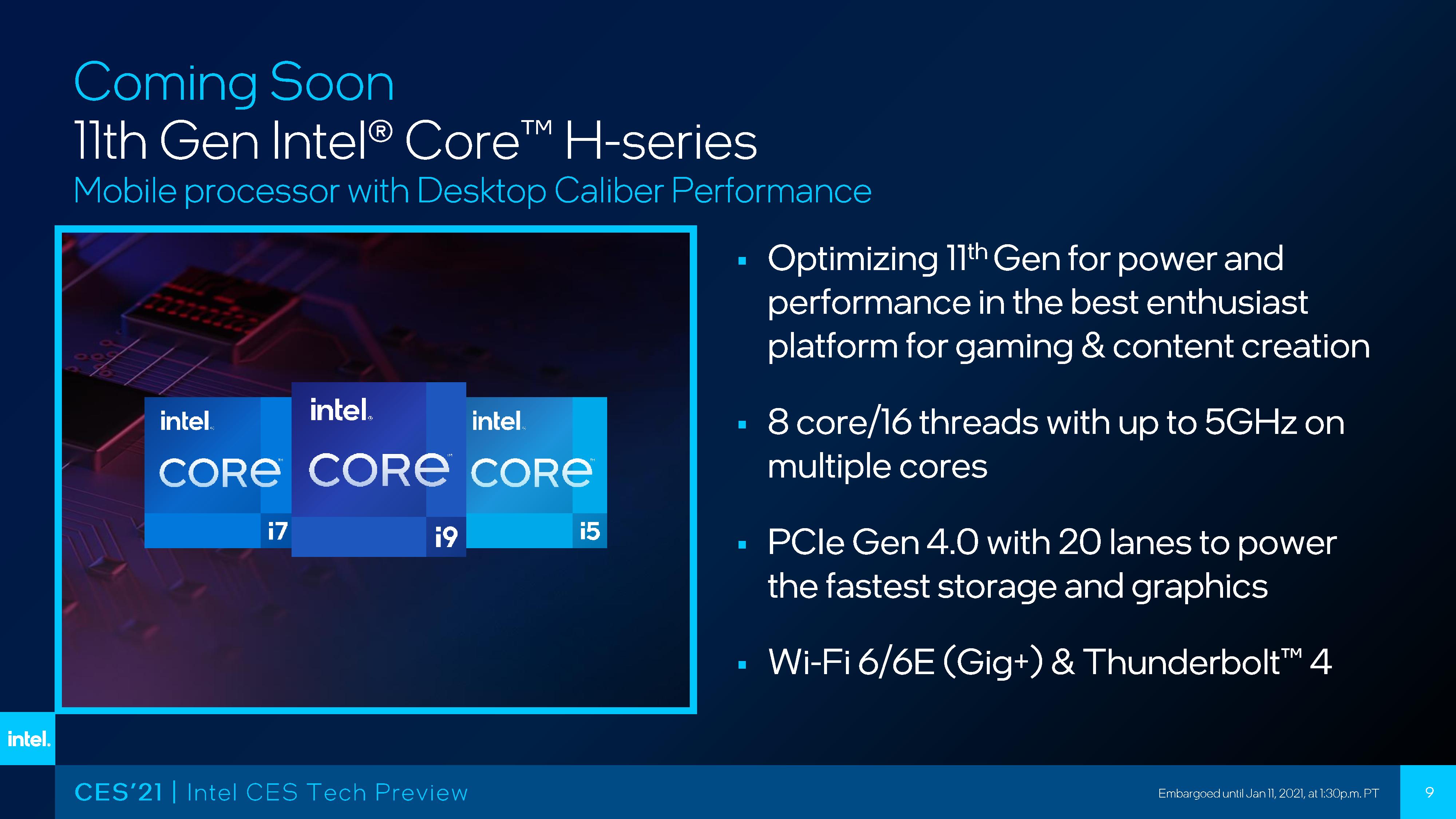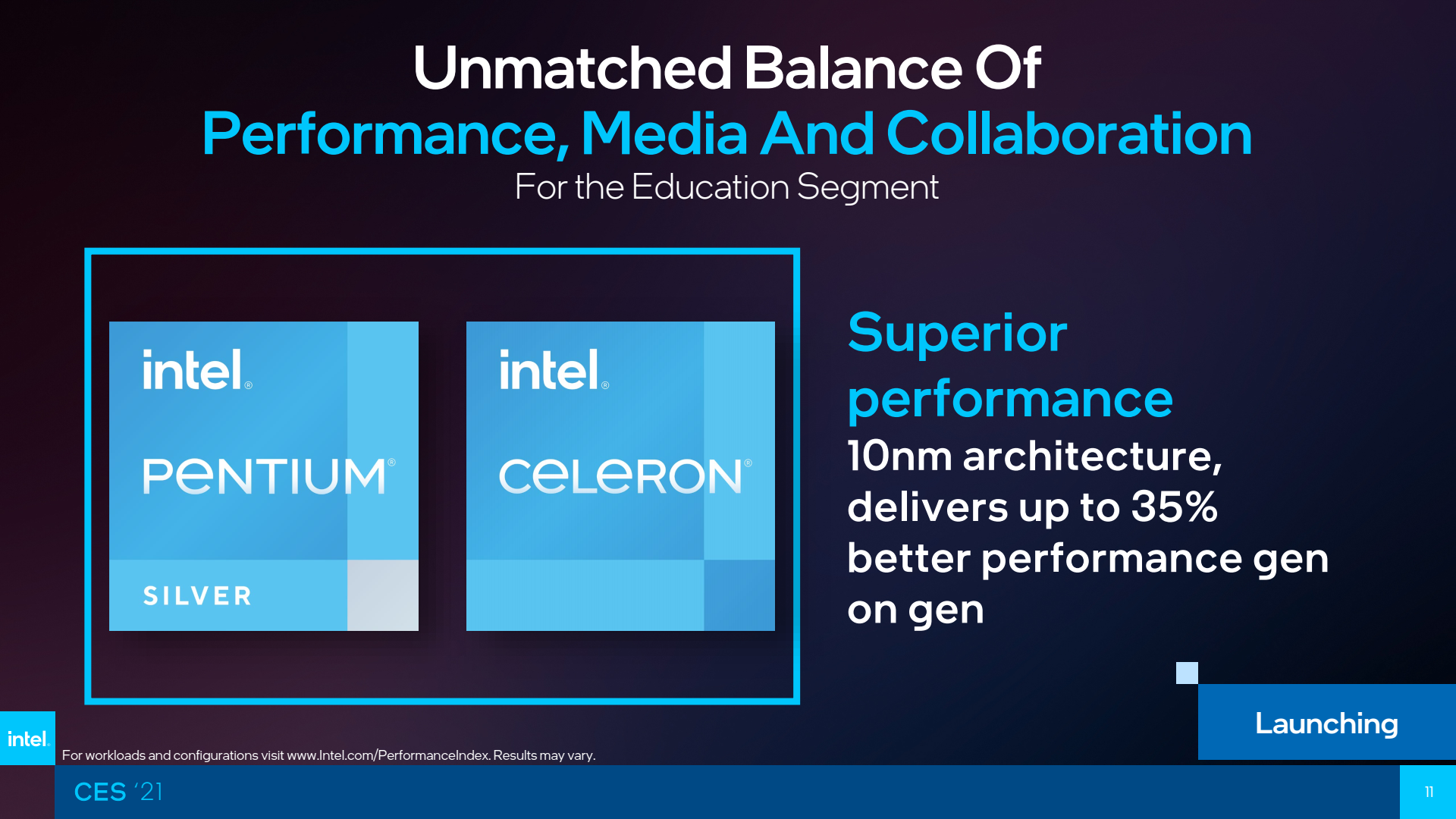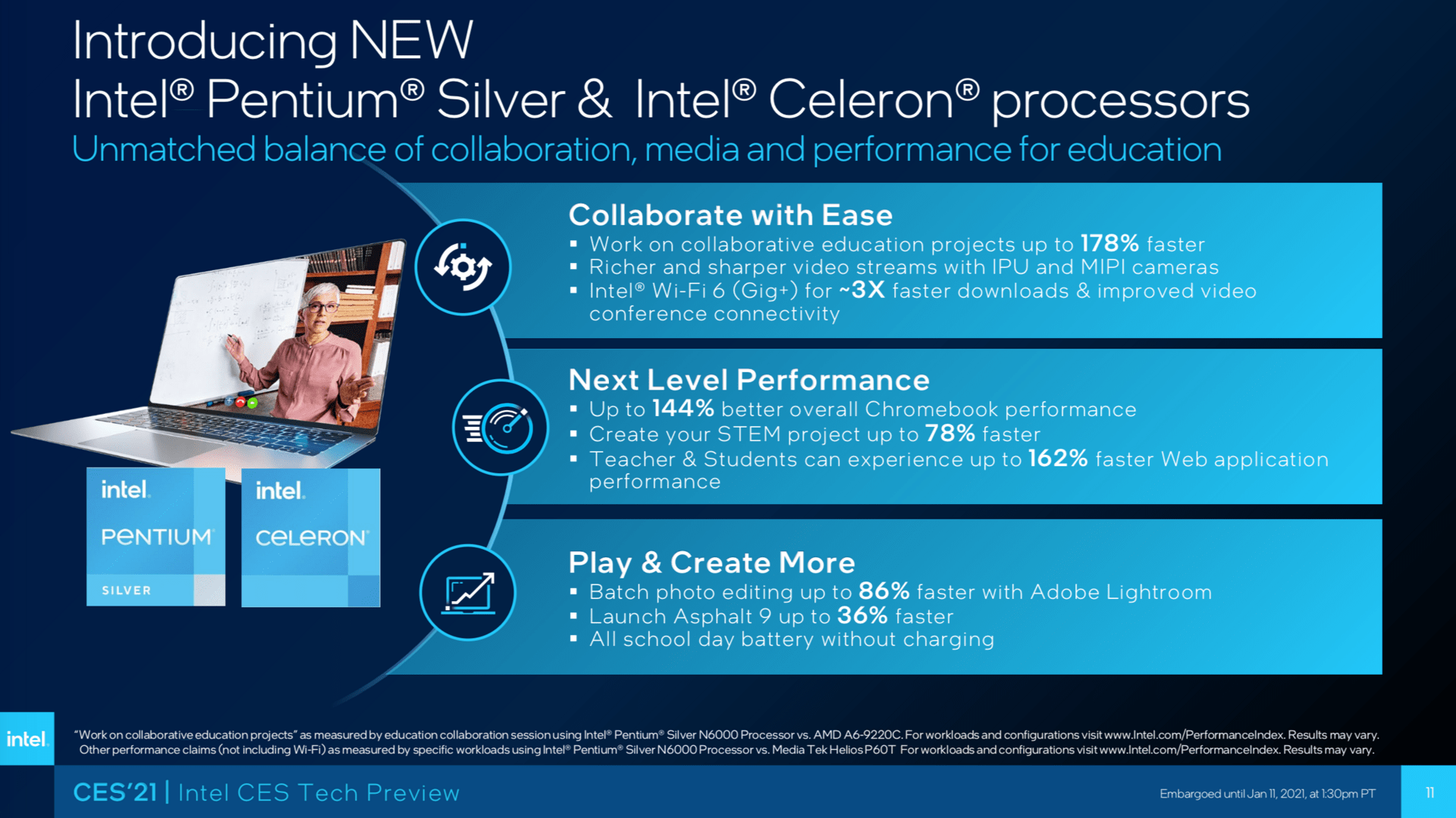Mobile 10nm processors: 8-core Tiger Lake-H, Tiger Lake-H35 and 10nm Tremont Atom, finally
Intel is likely at the point where it got out of the worst of the “never-ending 14nm process” period now: the company has unveiled three families of 10nm mobile processors at CES 2021, some clocked up to 5 GHz. And in addition to this, Rocket Lake processors for desktop. Those are still 14nm products (the last ones), but they finally bring a new – and potentially very good – architecture. All these CPUs will be released in Q1 2021.
Let’s keep desktop processors asside for a moment and start with the mobile processors. The first to ship will be more powerful 10nm processors for laptops. In the summer, Intel released 15W to 28W quad-core Tiger Lake-U processors and now two more powerful versions are coming. The first of these are the Tiger Lake-H35 processors. These have actually been released last week and should start appearing in notebooks.
Tiger Lake-H35: four cores for thinner gaming notebooks
These processors are not brand new. They use the same silicon as Tiger Lake-U (the designation H35 is therefore slightly misleading). The difference is that Intel uses 35W TDP here, which allows for higher performance (optionally, they can be limited to 28 W, so in theory they can overlap with the fastest U-series chips).
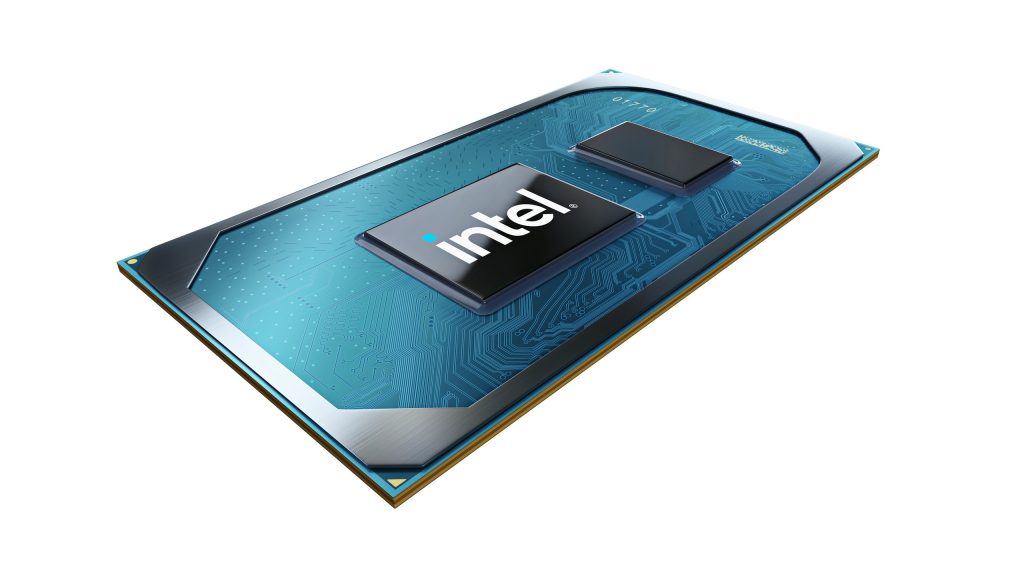
These processors therefore have just four cores with eight threads and an integrated Intel Iris Xe GPU with 96 EU (768 shaders). Intel launched a total of three models, which you can see in the table below. The cheapest Core i5-11300H has a base clock speed of 3.1 GHz at 35W TDP, all-core boost of 4.0 GHz and a maximum boost for 1–2 active cores of 4.4 GHz. It also has its L3 cache cut down to 8 MB.
However, the next two faster models are the more interesting ones. These have a 12MB L3 cache; The Core i7-11370H has a base clock speed of 3.3 GHz, a maximum all-core boost of 4.3 GHz and maximum boost for 1–2 cores of 4.8 GHz. The maximum is therefore the same as the fastest U-series Tiger Lake, Core i7-1185G7.

And that’s where the fastes model comes in, the Core i7-11345H Special Edition – that is, this CPU should have a special status, we are not yet sure how widely will it be available. This i7-11375H SE has the same parameters as the i7-11370H overall, except that it has a 5.0 GHz boost for one core. This is achieved using the Turbo Boost Max 3.0 technology, so this clock is only available on the so-called favored core and not on all of them. In any case it’s Intel’s fastest 10nm processor in terms of single-threaded performance.
These processors have the same integrated chipset and connectivity (for example Thunderbolt 4/USB4) as Tiger Lake-U, memory can be DDR4-3200 or LPDDR4X-4266. However, the limitations of the PCI Express controller of the U-silion also remain, which distances these quad-cores from the regular H-series processors. For a graphics card, only a PCI Express 4.0 ×4 interface is available (which is actually intended to be mainly used for SSDs with U-series processors).
This limits its potential a bit, on the other hand the bandwidth is the same as with PCI Express 3.0 ×8, so these processors will still be appropriate for more portable gaming laptops. Intel gives the example of devices with a thickness of only around 16 mm. Of course, such lighter gaming laptops can also rely just on the integrated Iris Xe GPU. By the way, when paired with an Nvidia GeForce RTX 3000 graphics card, it will be possible to use the PCIe Resizable BAR feature (similar to AMD Smart Access Memory) to improve performance. Intel says it has implemented it in close collaboration with Nvidia.
According to Intel, over 40 laptops with these processors from various manufacturers should appear during the first half of this year.
8-core Tiger Lake-H models
While the Tiger Lake-H35 is not very different from the U version, there are regular Tiger Lake-H processors coming after that as well. But Intel has not yet completely revealed them at CES 2021, just teased them. However, they are also expected to hit the market later this quarter, so they are not that far away. The company is still hiding specific models and parameters though.
Tiger Lake-H will have eight cores and probably 45W TDP. The core architecture should be exactly the same, so processors could have up to 24 MB of L3 cache. The GPU has the same Xe LP architecture but only gets 32 EU/256 shaders. That’s because these processors are expected to usually be paired with a powerful dedicated GPU in a gaming notebook.
And Tiger Lake-H will already have a proper support for them: the processor provides a PCI Express 4.0 ×16 interface, i.e. the GPU connectivity as fast as on the best desktop platforms of today (AMD Ryzen 5000). In addition, there is another PCIe 4.0 ×4 for NVMe SSDs. The Resizable BAR feature should also work with these processors.
5 GHz on multiple cores simultaneously
We don’t know the performance and parameters, but Intel said that these processors will also reach up to 5.0 GHz clocks. And not just on one core, but with multiple cores active too. Single-threaded performance should be very good, but this time multi-threaded as well thanks to eight 10nm cores. Tiger Lake-H could be well competitive against mobile 7nm APU with eight Zen 3 cores, which AMD introduced a day after Intel had its keynote as the mobile Ryzen 5000 (and we’ll look at them later in another article). It remains to be seen which processor will be more energy efficient.
Jasper Lake: 10nm Atom with Tremont architecture is here
The last mobile processors we need to discuss are Jasper Lake. This is also a completely new chip – the very first 10nm SoC of the cheap and at the same time power-efficient line of Atom processors with “small cores”. Jasper Lake delivers four cores using the Tremont architecture, manufactured on a 10nm process of the same type as the one used for Ice Lake processors (it is not the more powerful SuperFin variant from Tiger Lake).
Intel did not devote much time to Jasper Lake, which doesn’t surprise too much though, previous generations of these cheap processors were often launched with close to zero publicity. Intel has now announced Jasper Lake as a solution for Chromebooks, but as usual, they should probably be used in traditional laptops, mini PCs and mini-ITX boards too. Intel already considers them as launched to market, but the arrival of particular devices based on these chips might take a few weeks or months.
Jasper Lake comes in a total of six models – three 6W ships for laptops and three 10W chips for desktops. 10W models should consume up to 20 W while boosting, so these processors joins the list of Intel products on which TDP does not equal the maximum power draw. You can see the parameters of the models in the tables below.
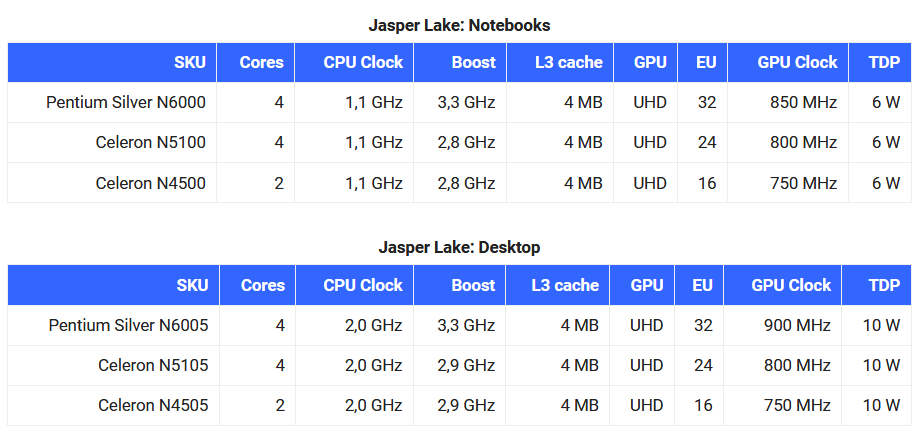
A Tremont core has significantly higher performance than the previous Goldmont+ architecture used in 14nm Gemini Lake Atoms/Celerons/Pentiums that are currently sold. The IPC should increase by up to 30%; according to Intel, the performance of processors should be up to 35% better than that of Gemini Lake. The processors support DDR4-2933 and LPDDR4X-2933 memory.
Integrated graphics should also be improved. For Pentium Silver models, it has 32 EU (256 shaders), but for quad-core Celerons, it is cut to 24 EU (192 shaders) and for dual-core to only 16 EU (128 shaders). The architecture is Gen11, like in Ice Lake processors. So this is not yet the latest Xe architecture from Tiger Lake processors. Therefore, AV1 decoding is likely not yet supported either.
On the next page, we’ll take a look at Rocket Lake desktop processors and the first showing of the next-gen Alder Lake CPU.
- Contents
- Mobile 10nm processors: 8-core Tiger Lake-H, Tiger Lake-H35 and 10nm Tremont Atom, finally
- 11th gen Core for desktop a.k.a. “Rocket Lake“. i9-11900K, the coming king of gaming PCs?





